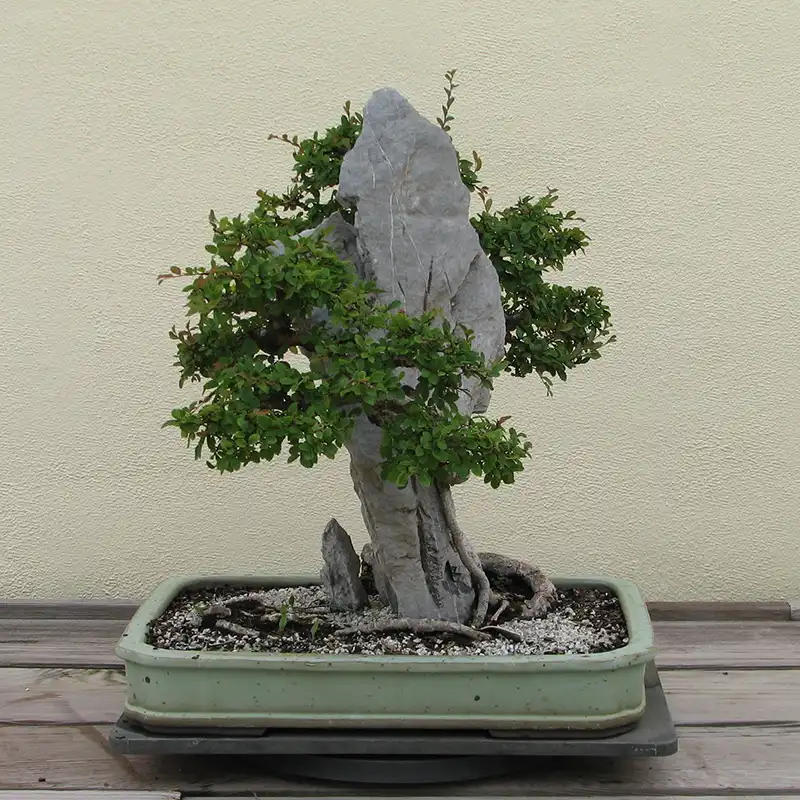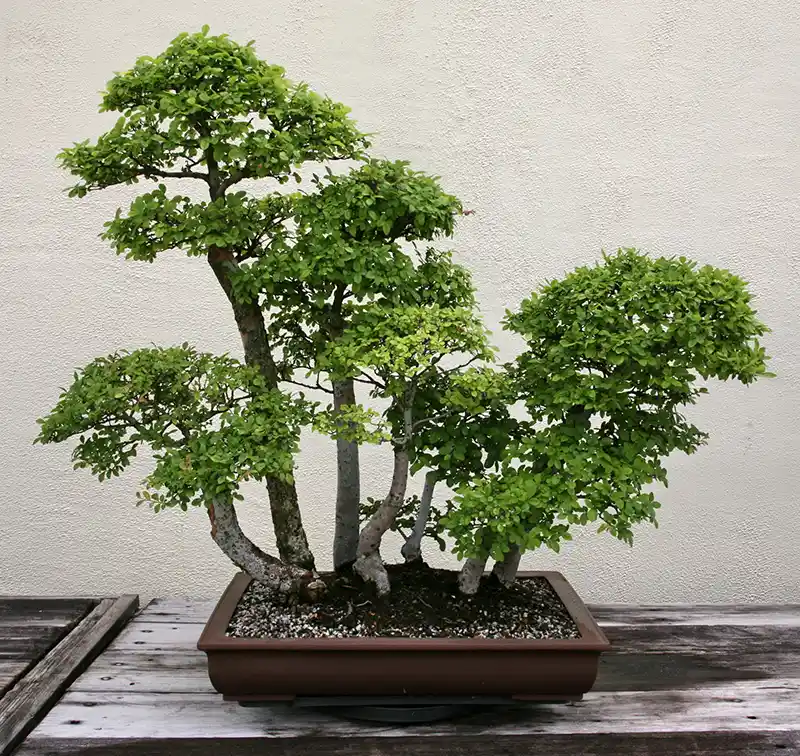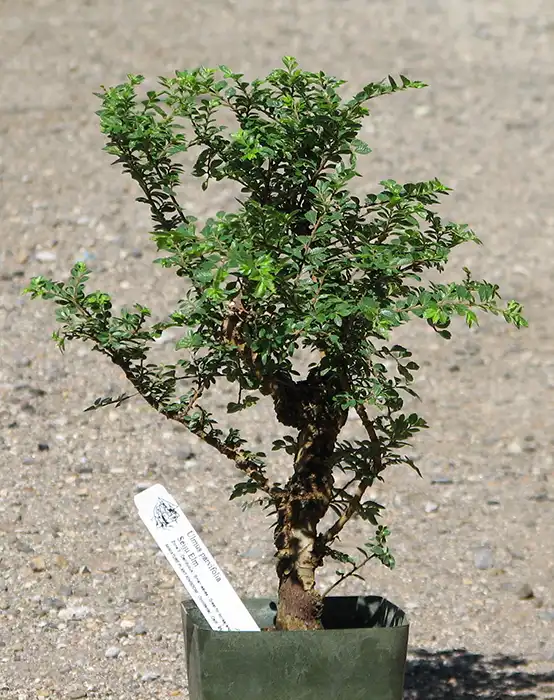True Green Chinese Elm
Ulmus parvifolia ‘ True Green’
Chinese elms are gorgeous trees that anyone can quickly grow, whether a newcomer or an experienced botanist. The tree is easily cared for and can be deciduous or evergreen, depending on where you keep it. The true green Chinese elm develops a scale-like bark that is beautiful to observe once mature.
Throughout this care sheet article, we’ll explain the various factors you need to know when growing a true green Chinese elm. We’ll also explain any considerations for indoor placement and common issues you may have while growing the tree.
Image courtesy of Ragesoss | License Details
Here's what you'll find in this species guide for the True Green Chinese Elm bonsai:
Here's what you'll find in this species guide for the True Green Chinese Elm bonsai:
01
02
03
04
05
Quick True Green Chinese Elm Bonsai Care Sheet
Here you’ll find a quick guide to the requirements and needs of your true green Chinese bonsai. For in-depth details, read the next section.
Recommended soil
Any well-draining mixture.
Watering
Check daily to ensure topsoil is dry before watering.
Potting season
Every second year while the tree grows rapidly. Once older, as needed.
Shaping and pruning season
Prune as needed. Larger branches in autumn.
Light
Full sun or partial shade.
Fertilizing
Use plenty of fertilizers while the tree is in its growing season. A balanced mix of solid and liquid options is ideal.
Propagation methods
Cuttings. Seeds are usable but not recommended.
Pests and diseases
Spider mites and scale in low humidity. Frequent misting with water helps deter these pests.
How To Care For Your Own True Green Chinese Elm Bonsai Tree
Caring for the true green Chinese elm isn’t hard. The plant needs are simple, and if it’s well taken care of, the tree will grow to be evergreen all through the year. Keep an eye on the temperature, pests, and ensure you repot as needed.
Best Soil
You don’t need to be picky when deciding what soil you need for a true green Chinese elm. Almost any mixture will work well when growing this tree. However, to help the bonsai thrive in its environment, use a well-draining option to help prevent any root damage.
Watering
The true green elm can sometimes be a nuisance to water, as no fully predefined schedule works. Timing will vary based on the soil you use and your climate. Be cautious, as the true green Chinese elm is especially vulnerable to droughts and overwatering.
For the best watering frequency, you should always touch the top layer of the soil and ensure it’s dry before hydrating your tree. However, for optimal checking to prevent any damage to the roots, plunge your finger slightly into the pot and feel around for any dampness.
Repotting
Repot this bonsai tree at least every two years while it’s still in the early growing phase. As you repot the tree, be sure to prune the roots carefully and inspect them for any signs of damage as you do so. Doing this will let you know if any root infection or injury has occurred due to watering.
Additionally, be sure to wash your bonsai containers after repotting. This process will help keep the tree safe from any infections. If you use drainage mesh, ensure it isn’t caught up in the tree’s roots, hampering future growth.
Shaping And Pruning
Prune the true green Chinese Elm as needed, all through the year. However, larger branches need to be cut only during the later months of autumn. Allow the twig’s shoots to reach three or four nodes before trimming them down to two.
Use standard wiring to shape a young true green Chinese elm. Slowly move the branches into place.
Location And Sunlight
This particular tree species can be grown both indoors and outdoors. The bonsai’s main requirement when choosing a location is the light level. As long as the tree has full or partial sun exposure, the tree will thrive. However, the bonsai may suffer from damage due to excessive heat when exposed to the summer afternoon sun.
Fertilizing
Use a standard solid and liquid fertilizer mixture to help the tree grow. Use plenty of this mixture during the tree’s growing season. If the tree loses its leaves during the winter and becomes dormant, the bonsai will not need any fertilizer.
Propagation Methods
When trying to propagate a true green Chinese elm bonsai, use cuttings. This method is the best to use and will yield optimal results. However, you can still grow a true green Chinese elm with seeds, a technique that will require more care and observation.
Pests And Diseases
Spider mites and scales are the most common pets you’ll find attracted to your Chinese elm bonsai. However, misting the tree with water every few days or regular insecticide will help keep these pests away. Most often, you’ll only find these small insects during times of lower humidity.
Image courtesy of Cliff | License Details
Considerations For Growing An Indoor True Green Chinese Elm
If you want to grow this tree indoors, two of your primary considerations are here. Do you want the tree to grow as evergreen or enter a hibernation state during winter? Additionally, can you ensure the room you place the tree in receives enough sunlight for the tree to survive?
Evergreen Or Seasonal
The true green Chinese elm bonsai is a semi-deciduous tree and, in a typical climate, will lose its leaves during the winter months. However, if kept indoors at a coolish temperature, the tree will remain evergreen through the year. This factor makes the plant ideal for indoor growth.
Sunlight Needs
The tree requires at least five hours of sunlight exposure per day, whether total or partial. The best location within your house to grow this tree is by a sun-facing window, an ideal one that receives the morning sun as summer afternoon sunlight can damage bonsai leaves.
Common Issues When Caring For A True Green Chinese Elm Bonsai
While caring for a bonsai can bring a few issues, here are two of the main ones you’ll face when growing your own true green Chinese elm. Be careful when watering and ensure the tree is pruned correctly after repotting.
Over And Under Watering
The true green Chinese elm bonsai is vulnerable to overwatering and periods of drought. As such, the tree requires careful attention when watering, and should be checked at least daily if the tree needs more water. Touch your finger to the soil, preferably digging it slightly in, feeling if there’s any moisture. When the dirt feels dry, it’s time to hydrate the bonsai again.
Repotting Needs
Ensure you clean the roots and pot thoroughly whenever you repot the tree. This process will help protect the tree while you have time to check the roots for any diseases or damage. Inspecting the roots is essential, as the tree’s prone to damage from overwatering.
FAQs About True Green Chinese Elm Bonsai
Here are a few frequently asked questions about the true green bonsai and the rest of the Chinese elm species. We’ll answer queries about the tree’s growth rate, whether it’s ideal for becoming a bonsai if it’s easy to care for, and how often you’ll need to prune it.
The Chinese elm species is a great variety to grow as a bonsai tree. Natively, these can grow to over 65 feet tall; however, they tower at much smaller heights in bonsai form. Overall, the tree is easy to care for and can be grown indoors and outdoors.
Yes, Chinese elm bonsai are great for growing indoors if their needs are met. Give the tree at least five hours of sunlight a day, water it every two days, and regulate the temperature. Growing a true green Chinese elm in a colder environment will keep it evergreen all through the year.
The natural version of the Chinese elm tree species grows between 12 to 26 inches every season. This growth rate is still rapid as a bonsai, requiring a careful eye when pruning and repotting.
Chinese elm bonsai are among the most accessible trees for beginners to grow and care for. The tree’s only main concern is overwatering and pests, as it is highly vulnerable to root issues if kept in constantly wet soil.
The Chinese elm is a deciduous bonsai tree, having great structure and leaves. However, in some cases, growing the tree indoors at a cooler temperature will prevent the tree from shedding its leaves. If grown in warmer conditions, the tree will be bare for part of the year.
As your Chinese elm grows considerably each year, you’ll need to prune it often. Allow the shoot to extend three or four nodes before cutting back up to two leaves. You’ll usually need to prune the tree at least three times per year.








